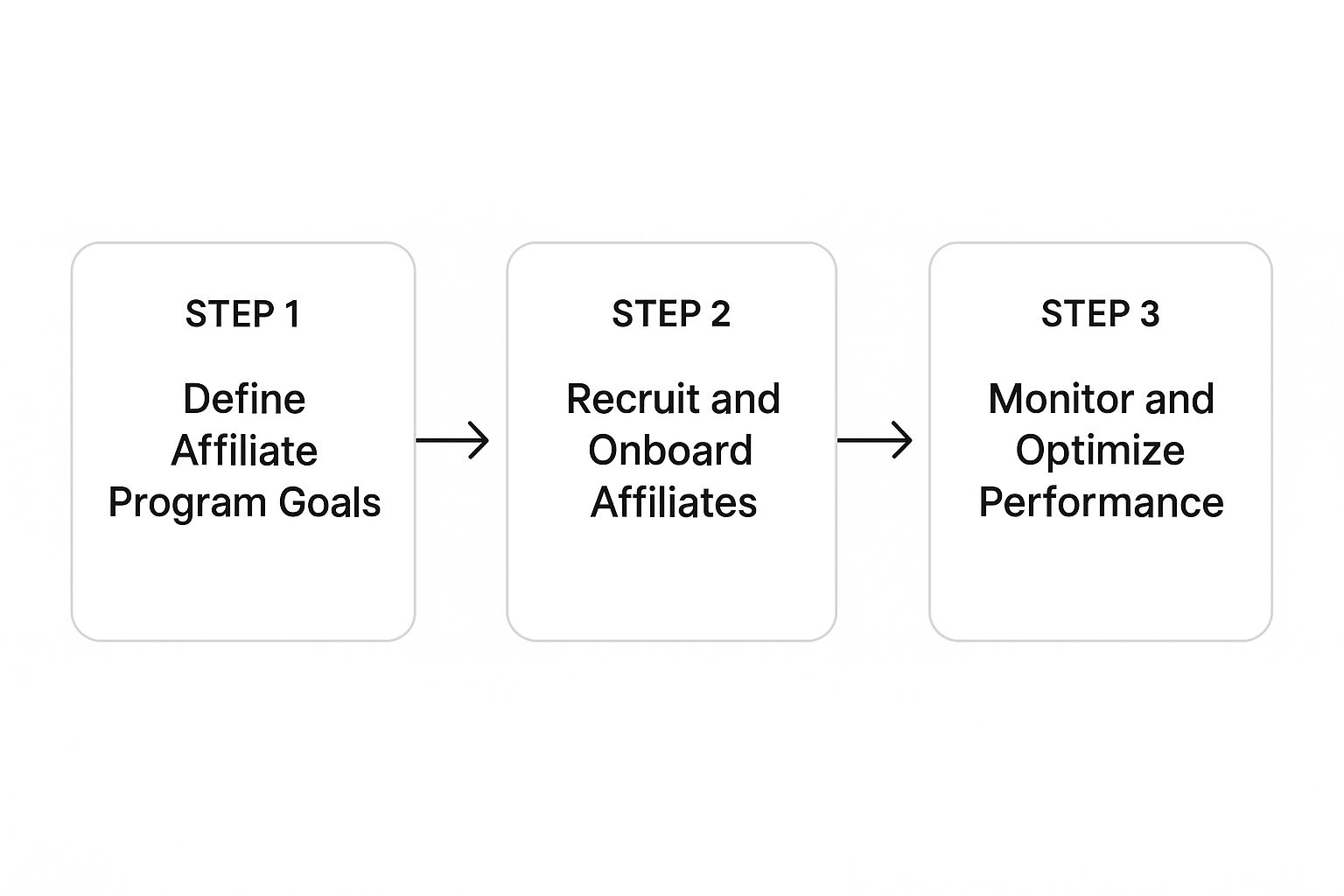To truly get the most out of an affiliate program, you have to think beyond just tracking links. It's about building a strategic partnership that drives mutual success. This means setting crystal-clear goals, crafting commission structures that actually motivate people, and getting your legal house in order from day one. Nail these fundamentals, and your program will shift from a simple sales channel to a genuine growth engine for your business.
Building Your Affiliate Program Foundation
Before you even think about recruiting your first affiliate, you have to lay the groundwork. This initial setup is everything—it will define the entire direction, profitability, and frankly, the long-term health of your program.
If you skip this part, you'll likely end up with the wrong partners, wasted time, and a lot of frustration. But a well-thought-out program acts like a magnet, attracting high-quality affiliates who can make a real difference to your bottom line.
Key Affiliate Program Components at a Glance
To get started, you need to define a few core elements. Think of these as the pillars of your program.
| Component | Key Considerations | Example Goal |
|---|---|---|
| Program Goals | What does a "win" look like? Is it lowering Customer Acquisition Cost (CAC)? Hitting a specific Monthly Recurring Revenue (MRR) target? Breaking into a new market? Get specific and make sure it's measurable. | Reduce CAC by 15% within the next six months. |
| Commission Structure | How will you reward partners? A flat fee per sale? Recurring commissions for subscriptions? A tiered model that pays more for top performers? Your model needs to be both attractive and sustainable. | Offer a 20% recurring commission on all subscription sales. |
| Legal Agreement | This is your safety net. The agreement must clearly define commission terms, payout schedules, marketing rules (like no brand bidding!), and how the partnership can be terminated. | Draft an agreement that prohibits affiliates from bidding on branded keywords. |
This table covers the absolute must-haves. Getting these right from the beginning saves you countless headaches down the road.
This visual gives you a great high-level overview of the entire process, and you'll notice it all starts with those foundational steps we just talked about.

As you can see, defining your goals is the critical first move that shapes everything else, from who you recruit to how you optimize performance later on.
Designing a Competitive Commission Model
Your commission structure isn't just a number—it’s a powerful message about how much you value your partners. A SaaS business, for instance, might offer a 25% recurring commission because they're focused on building long-term customer relationships. On the other hand, an e-commerce brand selling a $1,000 product might find a 10% flat-rate commission per sale is the perfect incentive.
The secret isn't just offering the highest payout. The best commission structure is one that fiercely motivates your affiliates while protecting your own profit margins. It's all about finding that sweet spot for your specific business model.
If you want to dig deeper into different strategies, our guide on how to https://refgrow.com/blog/manage-affiliate-program offers a ton of practical advice to get you started on the right foot.
The Importance of a Solid Affiliate Agreement
Finally, whatever you do, don't skimp on your affiliate agreement. This document protects you and your partners by setting clear expectations for everyone involved.
A classic example? Explicitly state that affiliates are not allowed to bid on your branded keywords in their paid search campaigns. This simple clause prevents them from driving up your own ad costs and directly competing with your marketing efforts.
To get a better handle on the legal and operational side of things, it’s worth exploring the concept of affiliate programs and their industry standards. A professionally drafted agreement prevents disputes and establishes a professional, trustworthy tone for your entire program.
Finding and Welcoming Your Best Affiliate Partners
An affiliate program is only as good as the people in it. You can't just set it and forget it; the real secret to success is actively finding and recruiting partners whose audience is a perfect match for your product. This is the bedrock of managing a truly effective affiliate program.
Think about it: top-tier creators and influencers get dozens of partnership requests every single day. Generic, mass emails are a one-way ticket to their trash folder. To get noticed, your approach needs to be personal, well-researched, and show them the value right from the start.

Pinpointing Your Ideal Partners
First things first, you need to build a list of potential partners who are already a natural fit for your brand. Forget about just chasing big follower counts. The goal is to find authentic creators who are already talking about the same problems your product solves.
A simple but powerful trick is to look at who your best customers already follow. What blogs are they reading? Whose YouTube channels are they subscribed to? Which podcasts are on their weekly rotation? These are the channels where your ideal partners live. For a more detailed playbook on this, check out our guide on https://refgrow.com/blog/how-to-recruit-affiliates.
Writing Outreach That Actually Gets a Reply
With your prospect list in hand, it's time to reach out. And no, a generic template won't cut it. Your message has to show you've actually done your homework.
Here’s how to craft an email that stands out:
- Reference their work specifically. Mention a recent blog post, video, or podcast episode you genuinely enjoyed. Explain why it resonated and how it ties into what your brand is all about.
- Focus on what's in it for them. Frame the partnership as a true win-win. Don't just talk about what they can do for you; explain how your product will genuinely help their audience and how your commission structure fairly rewards their hard work.
- Be brief and respect their time. Get straight to the point. End with a clear, low-commitment call to action, like suggesting a quick 15-minute chat to explore the idea further.
A personalized email that says, "I loved your recent video on productivity hacks, and I think our tool could solve the exact team collaboration problem you mentioned," is 10x more effective than a generic "Join our affiliate program" blast.
Designing a Flawless Onboarding Process
Getting a "yes" from a new affiliate is just the beginning. A clunky or confusing onboarding experience can completely derail their excitement before they even make their first referral. Your job is to make it ridiculously easy for them to get started.
This is where a tool like Refgrow really makes a difference. You can build a branded, step-by-step welcome experience directly within the platform. This proactive approach gives your partners the confidence and tools they need to start promoting you right away.
Your onboarding process should cover all the bases:
- A Welcome Kit: Give them instant access to everything they need, like logos, brand assets, and marketing guidelines.
- Product Education: Offer short video tutorials or a quick-start guide that breaks down your product's best features and selling points.
- Crystal-Clear Next Steps: Show them exactly where to find their unique referral link and how to track their clicks and commissions.
By investing a little time into creating a smooth onboarding flow, you're not just welcoming a new partner—you're setting the stage for a profitable, long-term relationship.
Keeping Your Affiliate Partners Activated and Engaged

Getting affiliates to sign up for your program is a great start, but it’s just that—a start. The real work begins now. How do you turn that initial interest into a steady stream of traffic and sales?
An affiliate who signs up and then goes silent is a massive missed opportunity. Your goal is to keep them active and motivated from day one.
The key is consistent, valuable communication. Forget about sending the occasional, random check-in. You need a regular rhythm. A monthly newsletter is a perfect tool for this, but only if it’s packed with things your affiliates can actually use. Think beyond just company updates—share success stories from other partners, give them a sneak peek at upcoming features, or offer some killer content ideas they can run with.
Arm Your Partners for Success
Your affiliates know their audience, but they don't know your product inside and out like you do. You have to give them the tools and creative assets they need to talk about your brand convincingly. A simple folder of banner ads just won’t cut it anymore.
Here’s what really moves the needle:
- Customizable Assets: Don’t just give them generic graphics. Offer Canva templates for social media posts that they can quickly tweak to match their own style.
- Unique Discount Codes: Inside a platform like Refgrow, you can generate unique, trackable discount codes for individual partners. This is a powerful incentive that makes their audience feel special.
- Product Deep Dives: Host a quick, informal webinar walking through a new feature or an advanced strategy. This gives them fresh content and shows you're invested in their understanding.
This isn’t just about being helpful; it's smart business. When you consider that 81% of brands have affiliate programs and see an average ROI of $15 for every $1 spent, you realize that success hinges on well-equipped partners. You can dig deeper into the power of affiliate marketing statistics to see just how crucial this is.
The goal isn't just to provide resources. It's to provide the right resources that make it incredibly easy for your partners to create their next piece of content about you.
Spark Motivation with Smart Incentives
Commissions are the main draw, of course, but creative incentives can ignite a fire under your program. They introduce a bit of friendly competition and give affiliates something extra to shoot for. This is how you keep the energy high and avoid stagnation.
Think about implementing performance-based rewards that celebrate milestones and encourage everyone to level up.
- Performance Bonuses: A simple cash bonus for hitting a specific target can be incredibly motivating. For example, offer a $250 bonus to any affiliate who brings in 20 new customers in a single month.
- Tiered Commissions: This is a classic for a reason. You can set up your program to automatically bump an affiliate’s commission rate from, say, 20% to 25% once they hit a lifetime referral goal.
- Friendly Contests: Run a quarterly competition for something like the "Most Creative Campaign" or "Highest New Customer Volume." The prize doesn't have to be huge—gift cards, swag, or extra product credits work great.
When you celebrate wins and create more ways for your partners to earn, you build a program that feels alive and rewarding. You’re not just managing affiliates; you’re building a community of genuine brand advocates who are excited to grow right alongside you.
Using Data to Actually Drive Performance
Launching your affiliate program is a huge step, but the real magic happens next. To get the most out of your partnerships, you have to stop guessing and start using data to see what's really going on. This is how you move from just having an affiliate program to running one that consistently grows your business.
Think of it this way: your analytics dashboard is your command center. It gives you the information you need to make smart, small tweaks that add up to big results over time. Don't get overwhelmed by all the numbers; we'll focus on the few that truly tell the story of your program's health.
https://www.youtube.com/embed/xpwLWlpv6AA
Focus on the Metrics That Actually Matter
It’s incredibly easy to get lost in a sea of data. The key is to ignore the noise and zero in on the Key Performance Indicators (KPIs) that directly tie back to your revenue and program health. These are your program's vital signs.
Here are the core numbers I always keep a close eye on:
- Conversion Rate: This is the big one—the percentage of clicks that actually become sales. If you see a low conversion rate, it’s often a sign of a mismatch between what the affiliate is promising and what the customer sees on your landing page.
- Click-Through Rate (CTR): This tells you how effective your affiliates are at getting their audience to click. A high CTR means their content is compelling and grabs attention.
- Affiliate-Specific ROI: You need to know which partners are truly profitable. Calculating the return on investment for each individual affiliate shows you who your all-stars are.
- Average Order Value (AOV): Are your affiliates bringing in big spenders or bargain hunters? Tracking AOV helps you see which partners attract the most valuable customers.
The Refgrow dashboard lays all of this out for you, making it simple to see who's performing and who might need a little help.
This kind of visual breakdown lets you spot trends instantly. You can see who's driving the most value and make much more strategic decisions about where to focus your time and resources.
Turn Those Numbers into Action
Data is worthless if you don't do anything with it. The insights you gather are conversation starters for you and your affiliates.
For example, if an affiliate has a fantastic CTR but a poor conversion rate, that’s a perfect opportunity to connect. Maybe they need a hand optimizing their call-to-action, or perhaps a different landing page would work better for their audience. A huge part of this is knowing how to improve website conversion rates on your end, too.
On the flip side, when you see a partner knocking it out of the park, reach out! Find out what’s working so well for them. You can then take their successful strategies and share them as best practices with your other affiliates, lifting up the entire program. This data-backed approach is why the affiliate channel is such a powerhouse; on average, businesses see $6.50 in revenue for every $1 spent.
Don't be afraid to experiment. Use your data as a launchpad for A/B tests. Try out different offers, tweak landing pages, or create new banners for specific affiliates. You'd be surprised how a simple headline change can lead to a significant lift in conversions.
By consistently watching your KPIs and acting on what you learn, you shift from simply reacting to problems to proactively building a more profitable and sustainable affiliate program.
Scaling Your Program and Preventing Affiliate Fraud
So, you've got your affiliate program off the ground and things are running smoothly. Awesome. The natural next step is to think about growth. But scaling isn't just a numbers game—it's about getting bigger and smarter while protecting the integrity you've built. As you grow, you unfortunately become a bigger target for fraud.
Staying ahead of these risks is absolutely key to building a healthy and sustainable affiliate channel. It's a balancing act: you want to expand your reach without letting the quality of your partnerships and customer trust take a hit.

Growing Your Roster and Automating the Grind
If you want to scale effectively, you have to work smarter, not harder. This is where automation becomes your best friend. To really expand your program while keeping communication and tracking in check, you might want to leverage marketing automation APIs. Automating the tedious, repetitive tasks frees you up to focus on the big-picture strategy, like finding new pools of affiliates to recruit.
Start looking for untapped niches that make sense for your brand. For example, if you've seen great results with marketing bloggers, why not explore YouTube creators who review business software? The idea is to find audiences that mirror your ideal customer.
Spotting and Stopping Common Affiliate Fraud
As your program becomes more successful, it will inevitably attract some bad actors. Affiliate fraud is a genuine threat that can bleed your budget dry and completely mess up your performance metrics. You've got to be vigilant and know what to look for.
Here are a few of the most common schemes to keep on your radar:
- Cookie Stuffing: This is a sneaky one. A fraudster drops multiple affiliate cookies onto a user's browser without them ever knowing. They end up getting credit for sales they had nothing to do with.
- Click Spam: This is a brute-force method where fraudsters send a massive volume of fake clicks, hoping a few of them happen to convert by pure chance, earning them an un-deserved commission.
- Ad Hijacking: This happens when rogue affiliates bid on your own branded keywords—something that’s almost always against the rules—to intercept your traffic and run it through their links.
Pro Tip: If you see a sudden, massive spike in clicks from one affiliate but their conversion rate is stuck at zero, that's a huge red flag for click spam. Always dig into data that looks out of place.
Auditing your traffic sources on a regular basis is non-negotiable for effective affiliate marketing program management. Use your platform’s tools to set up automated alerts that flag suspicious activity.
With U.S. affiliate marketing spend expected to hit a staggering $16 billion by 2028, the stakes are only getting higher. This kind of growth makes having a rock-solid fraud prevention strategy more crucial than ever.
By pairing intelligent expansion with diligent fraud prevention, you can scale your program with confidence, making sure it remains a powerful and trustworthy engine for your business.
Got Questions About Managing Affiliates? We've Got Answers.
Jumping into affiliate marketing always stirs up a few questions, especially when you’re just getting started. It's totally normal. To help you out, I’ve put together some straightforward answers to the questions I hear most often from people building their partner programs.
What's a Good Commission Rate to Offer?
Honestly, picking the right commission rate is more of an art than a science. There's no single magic number. It all comes down to your profit margins, your specific business model, and what’s competitive in your space.
A great first step is simply to see what your competitors or similar brands are offering. Are you a SaaS company? A recurring commission somewhere between 20% and 30% is a pretty standard and attractive offer that works well with a subscription model. If you're in e-commerce selling physical products, a one-time payout of 10% to 25% per sale is often more sustainable.
It's tempting to think the highest number wins, but that's not the whole story. The real goal is to find that sweet spot: a rate that attracts quality partners but doesn't sink your margins. I’m a big fan of tiered commissions—where the percentage goes up as affiliates hit certain sales goals. It’s a powerful motivator for your best people.
What Metrics Should I Actually Be Watching?
It's easy to get buried in data. To really understand what’s going on with your program, you need to ignore the noise and focus on a few key vital signs.
These are the numbers that will give you a real, actionable picture of your program’s health:
- Conversion Rate: This is your North Star. What percentage of the clicks your affiliates send are actually turning into sales? This tells you almost everything you need to know about the quality of their traffic.
- Average Order Value (AOV): Are your affiliates bringing in big spenders or small-time buyers? AOV helps you see the quality of the customers they refer.
- Revenue per Affiliate: This one is simple but crucial. It helps you quickly identify your all-stars—the partners who are genuinely moving the needle for your business.
- Customer Lifetime Value (CLV): Are affiliates bringing in one-and-done customers, or are they finding people who will stick around for the long haul? Tracking the CLV of their referrals is the ultimate test of partner quality.
Keeping a close eye on these metrics will tell you exactly what’s working, what isn't, and where you should focus your energy.
How Do I Keep My Affiliates Motivated?
This is the big one. An unengaged affiliate is an unproductive one. The secret isn't complicated: it's all about consistent, valuable communication and building a real relationship.
Think about sending out a regular newsletter. Don't just make it a sales pitch; fill it with genuinely useful stuff like upcoming promotions, content ideas, and success stories from other partners. Make their job easy by giving them a library of high-quality creative assets they can grab and use in a second.
And don't forget the fun stuff. Running a contest with a great prize or offering a special bonus for hitting a sales target can inject a ton of energy and healthy competition into your program.
At the end of the day, though, nothing beats a personal touch. A quick, genuine "Hey, just wanted to say you're crushing it!" email to one of your top performers can build more loyalty than almost anything else.
Ready to launch, track, and scale your affiliate program without all the usual headaches? With Refgrow, you can embed a fully native referral program directly into your SaaS in just a few minutes. Start growing with Refgrow today.

